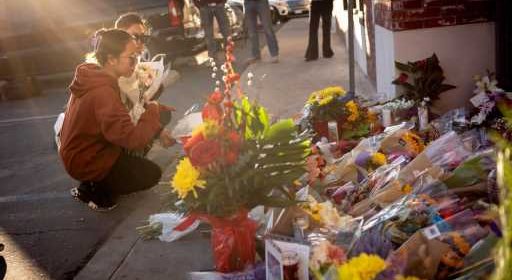Why Monterey Park, Half Moon Bay were — and weren’t — typical mass shootings – The Denver Post

Picture a mass shooter and an angry, racist, young and disturbed White male might come to mind.
The aging Asian men accused of this week’s mass shootings in Monterey Park and Half Moon Bay don’t fit that profile.
COMPLETE COVERAGE: Monterey Park Mass Shooting
“The typical profile is a younger, Anglo, male born in the U.S.,” Ben Newman, an associate professor in UC Riverside’s School of Public Policy and political science department, said via email.
“However, as more details are released, it seems as though these shooters shared key characteristics, such as mental health issues and some identifiable grievance, crisis and/or breaking point,” Newman said, citing research from The Violence Project and Voice of America.
What happened at mass shootings like Monterey Park and Half Moon Bay “should not be framed as Asian-American exceptions,” Dylan Rodriguez, a professor in UCR’s Department of Media and Cultural Studies, said via email.
Instead, those shootings should be viewed “as direct reflections of a national culture and climate that actively cultivates acts of repression and terror against women, criminalized and vulnerable people, and whomever else is deemed a target of resentment,” Rodriguez said.
“Mass shootings are the horrific logical expression of this national culture and climate.”
Police say 72-year-old Huu Can Tran, of Hemet, fired 42 rounds and killed 11 people late Saturday night, Jan. 21, at a Lunar New Year celebration at Star Ballroom in Monterey Park before a bystander disarmed him at an Alhambra ballroom. He eventually shot and killed himself inside a van in Torrance, police said.
In Half Moon Bay, 67-year-old farmworker Chunli Zhao was arrested after authorities said he gunned down seven people in two locations Monday afternoon, Jan. 23, in what’s being described as an act of workplace violence.
The age and race of both men differ from the average mass shooter.
A Tarleton (Texas) State University study of mass shootings from 1966 to September 2022 found that 45% were 29 or younger, with just 11% being 50 or older.
Four of roughly 180 mass shooters in that study were women — one of whom shot and killed 14 people with her husband in San Bernardino in 2015 — and only 6% were Asian. Fifty-two percent of shooters were White, though the percentage of White mass shooters fell from 61% between 1966 and 1999 to 46% since 2000.
White men are responsible for three of the deadliest mass shootings in U.S. history, including the murders of 60 people at a Las Vegas music festival in 2017 and 26 people — mostly schoolchildren — at Connecticut’s Sandy Hook Elementary School in 2012. The deadliest mass shooting by a person of Asian descent killed 32 at Virginia Tech in 2007.
In Orange County, a man born in Taiwan is accused of killing one and wounding four others with a semi-automatic pistol at a Laguna Woods church banquet for a priest visiting from Taiwan in May 2022. Authorities said David Wenwei Chou harbored deep hatred for Taiwanese people and their government.
Most mass shootings happen in the workplace — like the one in Half Moon Bay — or places of commerce, according to The Violence Project, a public criminology nonprofit organization that compiled an online mass shooter database. As in Monterey Park, most mass shooters used handguns, the project found.
In a June 2022 PBS News Hour interview, Jillian Peterson, the project’s co-founder and president, talked about a “common pathway to violence” shared by many mass shooters.
“It often started with (a) kind of serious violence in childhood,” Peterson told PBS. “Different forms of trauma kind of laid the foundation. Then you see, over time, a build where they become isolated, depressed, hopeless … Then that self-hate kind of turned outward, and you see perpetrators finding who it is that they blame for how awful they feel.”
Most mass shooters aren’t strangers to the places where they kill, Peterson added. “They’re not these kind of scary bad guys coming in. They’re kids who go to that school. They’re our classmates. They’re our neighbors. They’re our co-workers.”
Besides being more frequent and deadly, mass shootings are increasingly occurring in clusters “where one shooting is accompanied by several more shortly after,” Newman said.
“Journalists and academics call this a ‘contagion effect, ’and we know that many shooters study the actions of past mass shooters and feel emboldened by the occurrence of mass shootings.”
A 2021 study by the Educational Fund to Stop Gun Violence found that two-thirds of mass shootings are domestic violence incidents or committed by people with a history of domestic violence. CNN reported that Tran, once a Star Ballroom regular, met his wife there.
The couple divorced in 2005, and Tran’s ex-wife said that while Tran was never violent toward her, he was quick to anger, according to CNN.
According to court documents, Zhao, the alleged Half Moon Bay shooter, threatened to suffocate and use a knife to split open the head of a restaurant co-worker in 2013.
The Violence Project found that while 30% of mass shooters experienced psychosis — a disconnection with reality — only 10% acted on hallucinations. Many mass shooters are actively suicidal and 80% were in a “noticeable crisis” and showed signs like abusive behavior or feeling agitated or isolated beforehand, the project found.
If a mass shooter is mentally ill, “this doesn’t mean that their every action is related to that diagnosis or that their symptoms caused them to pull the trigger,” according to a statement included in key findings on the project’s website.
“All we can say with some degree of certainty is that no one living a fulfilled life perpetrates a mass shooting.”
Source: Read Full Article

